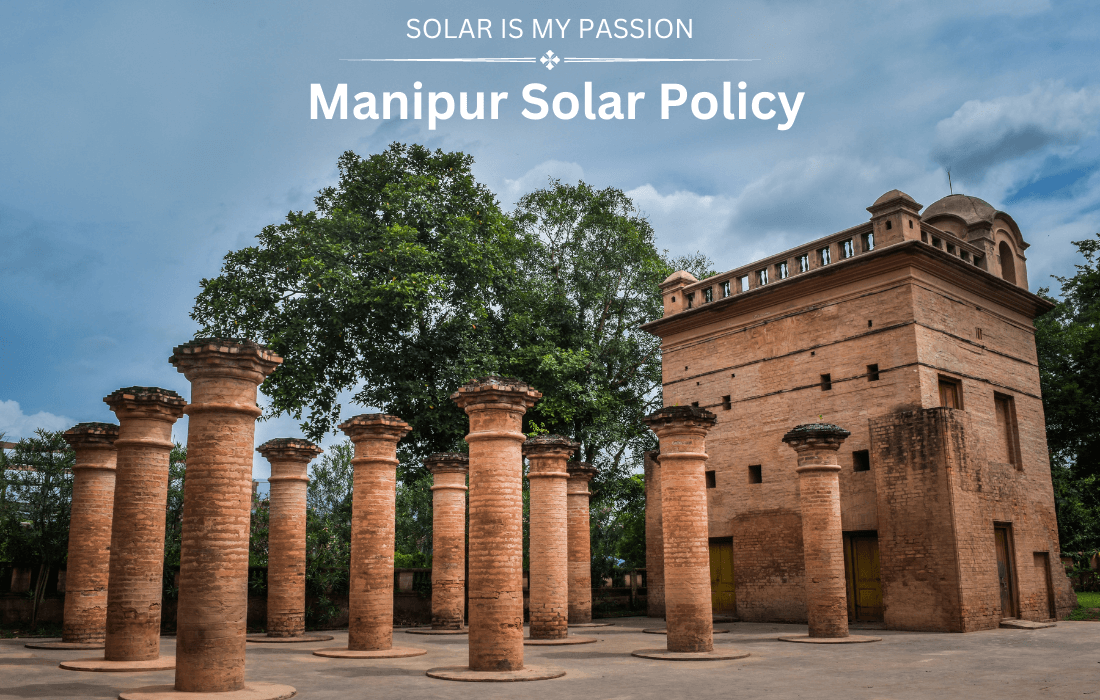No.9/9/2014-S&T(MANIREDA)- In pursuance of the decision of the State Cabinet taken on 1st December 2014, the Governor of Manipur is pleased to adopt “MANIPUR GRID INTERACTIVE ROOFTOP SOLAR PHOTO-VOLTAIC (SPV) POWER POLICY, 2014” for promoting grid quality solar power generation, which shall come into force from the date of publication in the Manipur Gazette as below:
1.0 Objective of Manipur Solar Policy
1.1 Energy is the key driver of growth in any Economy. The biggest challenge in the world today is to meet the rising demand of energy on a sustainable basis especially in view of limitations on natural resources (fossil fuels) to generate energy. The challenge is more pronounced in our country with limitation of resources and ever-increasing demand in view of our high population. The availability has always been behind demand and it is very likely that the present trend will continue for at least a few more years. In order to supplement the scarcity on a sustainable basis, it is necessary to move towards renewable sources of energy in the State. This policy aims to lay a framework for harnessing the ubiquitous Solar energy in the State by utilizing the empty rooftops of the buildings in the State. This policy is also a mandate and in synergy with to provisions of The Electricity Act. 2003.
1.2 There is a large potential available for generating solar power using unutilized space on rooftops and wastelands around buildings. Small quantities of power generated by each individual household, industrial building, commercial buildings or any other type of building can be used to partly fulfil the requirement of the building occupants and surplus, if any, can be fed into the Grid.
1.3 Some advantages of the Manipur Solar Power Policy
a. Solar power is pollution free. No greenhouse gas is emitted after installation.
b. Reduced dependence on foreign oil and fossil fuels.
c. Renewable clean power that is available every day of the year, even cloudy days produce some power.
d. Reasonable Return on investment.
e. Virtually no maintenance as solar panels last over 25-30 years.
f. Excess power can be sold back to the power company through intertied grid.
g. Ability to live without power from Grid if all power generated provides enough for the home/building.
h. Safer than traditional electric current.
i. Solar energy fed to the grid under Rooftop SPV scheme can be accounted for RPO (Renewable Purchase Obligation).
j. Saving in transmission & distribution losses for the utility.
k. No requirement of additional land. l. Local Employment generation.
1.4 Manipur has a good potential of Solar Energy. About 280-300 sunny days are available in the State which provide an excellent potential for installation of Rooftop and other Small Solar Power Plants in the State. The sunshine period per day on an average comes to about 8-10 hours, of which effective solar energy would be for about 4.5-6 hours per day.
1.5 The price of power generated from solar plants installed today is at par with or lower than the commercial tariff for consumers. The cost of solar power is on the decline while the cost of fossil fuel based electricity is increasing day by day. It is important to popularize the use of solar energy so that people gain confidence and start using solar options more and more, wherever feasible.
1.6 The Ministry of New and Renewable Energy (MNRE) Govt. of India is providing Central Financial Assistance(CFA) upto 30% of benchmark cost for all types of residential buildings for General Category States and upto 70% for North Eastern States. Similar CFA is also available for schools, health institutions including medical colleges & hospitals, universities, educational institutions and other Social Sectors such as welfare homes, NGOs, training institutes, orphanages etc.
No CFA is applicable for Government/PSU buildings, Government Institutions, Private/Commercial/Industrial buildings.
The MNRE revise Central Financial Assistance(CFA) for rooftop solar power plants from time to time, details are available in; www.mnre.gov.in.
CFA shall be applicable as per norms of the Ministry.
2. THE SCHEME:
2.1 General: Keeping the above in view, grid interactive rooftop solar plants will be supported under this scheme. The generated power from such SPV system/project will be utilized fully for powering captive loads during the day time and excess power will be fed into the Grid as long as Grid is available. In case solar power generation is not sufficient due to cloud cover etc., the captive loads will be served by drawing power from the Grid. The connectivity of such projects will be either at 33KV/11KV three phase lines or of 440/220 volt three/single phase line depending on the system installed. Ideally, grid interactive systems do not require battery back-up as Grid acts as the back-up for feeding excess solar power and vice-versa. However, to enhance the performance reliability of the overall system, a minimum battery back-up of one hour of load capacity is recommended. In Grid interactive systems, it has, 3 however to be ensured that in case the Grid fails, the solar power has to be fully utilised and feeding to the grid (if any in excess) be stopped immediately so as to safe-guard any grid person/technician from getting shock (electrocuted) while working on the grid for maintenance etc.
2.1.1 Subject to limits and other terms and conditions specified in the policy, the eligible consumers of the distribution licensee shall be entitled to install solar rooftop projects either under gross metering arrangement or net metering arrangement.
Provided that eligible consumer availing net metering shall not be allowed to apply for gross metering with same premises.
2.2 Tariff system: The feed in tariff for the power generated from solar power plant will be decided by JERC in such a manner that it provides safeguards to all stakeholders including DISCOMs. Such tariff will be applicable for the electricity exported into the grid; whether under net metering framework (i.e. surplus export after self-consumption at the end of annual settlement period, i.e. financial year end) or gross metering framework. The availability of electricity grid near solar installation is an essential component which needs to be provided by the concerned agencies i.e. MSPDCL or MSPCL as the case may be.
2.3 Metering System: Net and Gross metering facility will be implemented for the consumers of MSPDCL who intend to encourage solar green energy and set up solar PV plants at available places on roof-top. Individual households, industries, offices, commercial establishments, institutions, residential complexes etc. will be eligible for project capacity of minimum 1 KW upto a maximum of 500 KW with/without battery back-up support.
All the equipment to be installed like solar PV panels, inverters, synchronizer, MPPT, batteries, transformers, cables, junction boxes etc. shall be as per specified Indian/IEC standards. MSPDCL shall install/seal tested bi-directional (export & import) or separate export & import energy meters for all Solar PV projects. However, the same could be purchased by the Plant owner or provided by the MSPDCL at pre-notified rates. The meters should be as per CEA and BIS specifications only.
2.4 Capacity: The maximum capacity of the Rooftop Top Solar PV system shall not be more than sanctioned connected load or contract demand in case the consumer applies under net metering framework (subject to maximum of 500 kW) while there will be no such capacity restriction under the gross metering framework (subject to maximum of 500 kW).
2.5 Eligibility and Targets under the scheme : The policy aims to utilize the existing roof space of buildings for the roof-top SPV systems to replace DG gensets installed for minimum load requirement for operation during load shedding. It also aims to harness the available potential for generating solar power using unutilized space, along with promotion of green and clean power to reduce the dependence on conventional source of energy.
All the individuals, residential/commercial/Govt./Semi-Govt. building owners, Industrial units are eligible to set up Rooftop Solar Power Plant within the prescribed capacity limit. Eligible project capacity limit under the scheme will be from 1 KW upto 500 4 KW. A total capacity of 50 MW is targeted to be covered by the year 2022, out of which capacity under net metering shall be 30MW and under gross metering 20 MW on first come first serve basis. Actual target will be subject to sanctioned capacity by the Ministry(MNRE).
Manipur DISCOM official website: Manipur State Power Distribution Company Limited (MSPDCL) –https://solar.mspdcl.info


